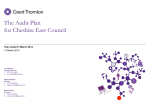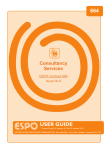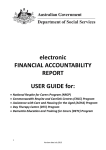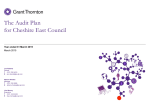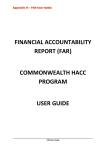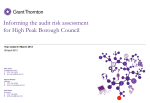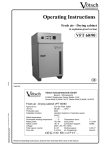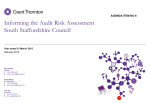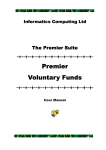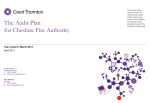Download The Audit Plan – template user guide
Transcript
Informing the audit risk assessment for Cheshire East Council Year ended 31 March 2014 Jon Roberts Partner T 0121 232 5410 E [email protected] Allison Rhodes Audit Manager T 0121 232 5285 E [email protected] Naomi Povey Executive T 0121 232 5294 E [email protected] © 2014 Grant Thornton UK LLP | Informing the Risk Assessment | 18 March 2014 The contents of this report relate only to the matters which have come to our attention, which we believe need to be reported to you as part of our audit process. It is not a comprehensive record of all the relevant matters, which may be subject to change, and in particular we cannot be held responsible to you for reporting all of the risks which may affect your business or any weaknesses in your internal controls. This report has been prepared solely for your benefit and should not be quoted in whole or in part without our prior written consent. We do not accept any responsibility for any loss occasioned to any third party acting, or refraining from acting on the basis of the content of this report, as this report was not prepared for, nor intended for, any other purpose. . Contents Section Page Purpose 4 Fraud 5 Fraud Risk Assessment Laws and Regulations Impact of Laws and Regulations Going Concern Going Concern Considerations 6 - 17 18 19 -20 21 22 – 25 Accounting Estimates 26 Consideration of Accounting Estimates 27 Related Parties 28 - 29 Appendix A Accounting Estimates 30 - 35 © 2014 Grant Thornton UK LLP | Informing the Risk Assessment | 18 March 2014 Purpose The purpose of this report is to contribute towards the effective two-way communication between auditors and Cheshire East Council 's Audit and Governance Committee, as 'those charged with governance'. The report covers some important areas of the auditor risk assessment where we are required to make inquiries of the Audit and Governance Committee under auditing standards. Background Under International Standards on Auditing (UK and Ireland) (ISA(UK&I)) auditors have specific responsibilities to communicate with the Audit Committee. ISA(UK&I) emphasise the importance of two-way communication between the auditor and the Audit Committee and also specify matters that should be communicated. This two-way communication assists both the auditor and the Audit Committee in understanding matters relating to the audit and developing a constructive working relationship. It also enables the auditor to obtain information relevant to the audit from the Audit Committee and supports the Audit Committee in fulfilling its responsibilities in relation to the financial reporting process. Communication As part of our risk assessment procedures we are required to obtain an understanding of management processes and the Audit and Governance Committee's oversight of the following areas: • fraud • laws and regulations • going concern. This report includes a series of questions on each of these areas and the response we have received from the Council's management. The Audit and Governance Committee should consider whether these responses are consistent with the its understanding and whether there are any further comments it wishes to make. © 2014 Grant Thornton UK LLP | Informing the Risk Assessment | 18 March 2014 Fraud Issue Matters in relation to fraud ISA(UK&I)240 covers auditors responsibilities relating to fraud in an audit of financial statements. The primary responsibility to prevent and detect fraud rests with both the Audit and Governance Committee and management. Management, with the oversight of the Audit and Governance Committee, needs to ensure a strong emphasis on fraud prevention and deterrence and encourage a culture of honest and ethical behaviour. As part of its oversight, the Audit and Governance Committee should consider the potential for override of controls and inappropriate influence over the financial reporting process. As auditor, we are responsible for obtaining reasonable assurance that the financial statements are free from material misstatement due to fraud or error. We are required to maintain professional scepticism throughout the audit, considering the potential for management override of controls. As part of our audit risk assessment procedures we are required to consider risks of fraud. This includes considering the arrangements management has put in place with regard to fraud risks including: • • • • assessment that the financial statements could be materially misstated due to fraud process for identifying and responding to risks of fraud, including any identified specific risks communication with the Audit and Governance Committee regarding its processes for identifying and responding to risks of fraud communication to employees regarding business practices and ethical behaviour. We need to understand how the Audit and Governance Committee oversees the above processes. We are also required to make inquiries of both management and the Audit and Governance Committee as to their knowledge of any actual, suspected or alleged fraud. These areas have been set out in the fraud risk assessment questions below together with responses from the Council's management. © 2014 Grant Thornton UK LLP | Informing the Risk Assessment | 18 March 2014 Fraud risk assessment Has the Council assessed the risk of material misstatement in the financial statements due to fraud? What are the results of this process? Management response The Council’s risk management process has identified the following as a Strategic Risk : “Financial Control: Risk that the Council fails to manage expenditure within budget, due to inaccurate financial planning in both the short term and longer term and/or ineffective financial control leading to a failure to maintain an adequate level of reserves, thereby threatening financial stability and service continuity and preventing the achievement of Cheshire East’s objectives and outcomes”. In addition, a specific fraud risk has been identified and included in the strategic risk register: Fraud Risk: Risk that the Council fails to have proper, adequate, effective and efficient management arrangements, policies and procedures in place to mitigate the risk of fraud, particularly at a time of financial hardship, such that public money is misappropriated. This would result in a loss of funds to the Council, have a detrimental effect on services users, a negative impact on the Council’s ability to achieve all of its priorities, value for money, and may have a negative impact on the Council’s reputation. These risks are subject to on going review in accordance with the Council’s Risk Management Strategy with the Financial Control Risk last formally reviewed in January 2014 and the Fraud Risk in November 2013. © 2014 Grant Thornton UK LLP | Informing the Risk Assessment | 18 March 2014 Fraud risk assessment continued What processes does the Council have in place to identify and respond to risks of fraud? processes does the Council have in place to identify and respond to risks of does the Council have in place to identify and respond to risks of fraud? Management response In addition to the strategic risks identified at page 6, a detailed Fraud Risk Assessment has also been produced in order identify service specific risks to which the Council may be vulnerable. This assessment was initially produced by the Risk and Performance Manager and the Principal Auditor (Fraud) and took into account the areas identified in the Strategic Fraud Risk, local knowledge and also those risks identified in national publications such as Protecting the Public Purse and Fighting Fraud Locally. This risk assessment was presented to and endorsed by Corporate Risk Management Group prior to circulation to service managers. Managers were asked to: • Identify and further risks to which their service area was exposed, and; • Annotate the assessment with existing and planned controls. The recently appointed Head of Stewardship and Resources has been allocated as owner of the strategic fraud risk along with the detailed assessment, and, as such will be responsible for the regular review and update of the register in conjunction with the Risk and Performance Manager. Further work is ongoing to embed awareness of fraud risks within the wider risk management process to ensure that fraud risks are identified and mitigating controls put in place in a timely manner. © 2014 Grant Thornton UK LLP | Informing the Risk Assessment | 18 March 2014 Fraud risk assessment continued Have any specific fraud risks, or areas with a high risk of fraud, been identified and what has been done to mitigate these risks?, or areas with a high risk of fraud, been identified and what has been done to mitigate these risks? the Council have in place to identify and respond to risks of does the Council have in place to identify and respond to Management response In developing the Strategic Fraud Risk the findings from the NFA Fraud Loss Profile Tool were used to identify the potential level of exposure that the Council was subject to in high risk areas. This identified Council Tax, Procurement and Payroll as key risk areas and each has been assessed in detail in producing the Fraud Risk Assessment. As previously stated further work is ongoing to engage service managers in the process and further embed fraud awareness across the authority. Housing Benefit Fraud is a high risk area for all authorities and CEC has established arrangements in place to investigate prosecute and recover losses suffered as a result of benefit fraud. The Benefit Fraud Team is responsible for all benefit fraud investigations and prosecutions. The Benefits Anti Fraud and Corruption Strategy, which deals specifically with welfare benefits issues, is complimentary to the main Anti Fraud and Corruption Policy. The benefits service strategy is supplemented by the Benefits Fraud Sanction Policy which outlines the criteria used to determine which sanctions may be applicable if a case is proven by the Investigation Team. In addition to a confidential reporting procedure the benefit investigation team also operate a separate hotline, for use by members of the public. The freephone number is 0800 389 2787. Referrals may also be made from the national fraud hotline managed by central government. These hotlines are publicised in relevant council literature as well as targeted media campaigns. A recent management restructure within the Council has taken the opportunity to bring together investigative resources from Housing Benefits, Trading Standards and the accredited Financial Investigators into a single Community Investigations Fraud Team. The scope of this team is currently being determined alongside a review of the corporate anti fraud arrangements in order to further develop the effectiveness of the anti fraud culture across the council and ensure investigative coverage for the whole range of identified fraud risks. © 2014 Grant Thornton UK LLP | Informing the Risk Assessment | 18 March 2014 Fraud risk assessment continued Are internal controls, including segregation of duties, in place and operating effectively? If not, where are the risk areas and what mitigating actions have been taken?r areas with a high risk of fraud, been identified and what has been done to mitigate these risks? the Council have in place to identify and respond to risks of does the Council have in place to identify and respond to Management response The AGS ensures a continuous review of the Council’s governance arrangements, to give assurance on the effectiveness of the arrangements and/or to address identified weaknesses including the application of internal controls. The AGS is considered by the Corporate Leadership Board with the collection of evidence for, and the drafting of it being the responsibility of the Corporate Governance Group. The review of governance arrangements in place is informed by the work of Internal Audit and senior managers and also comments made by the External Auditors and other review agencies/inspectorates. Sources of assurance include the Directors, Heads of Service and senior managers signing off on the adequacy of controls within their service areas/directorate via disclosure statements. The disclosures are made available to and considered by the Audit and Governance Committee in order that Members may discharge their duties with regard to approving the AGS. Where weaknesses are identified they are addressed by the production of an action plan which is subject to monitoring by senior management and Internal Audit as part of the Council’s Consolidated Action Plan (CAP). The production of the AGS also takes into account the annual internal audit opinion which provides assurance as to the adequacy of the Council’s system of internal control and the action taken to ensure that any shortcomings are rectified promptly. With regards to the production of the AGS for 2013/14 a draft statement and action plan will be presented to Audit and Governance Committee in June 2014 along with Internal Audit’s Annual Report, and the final version will be put in front of the September 2014 meeting of the Committee. Internal Audit work also provides assurance as to the effectiveness of internal controls and, where weaknesses are identified, mitigating actions are recommended to managers. © 2014 Grant Thornton UK LLP | Informing the Risk Assessment | 18 March 2014 Fraud risk assessment continued and what has been done to mitigate these risks? the Council have in place to identify and respond to risks of does the Council have in place to identify and respond to Management response continued A programme of audits is carried out in accordance with the Audit Plan that is approved by the Audit and Governance Committee .The work includes the Council’s fundamental financial systems in order to gain assurance that the systems of financial control are in place and operating effectively. Internal Audit undertakes testing on internal controls by examining their effectiveness and in this way the Council can gain reasonable assurance with regard to the potential for override of management controls or other inappropriate influence over the financial reporting process. The outcome of each audit assignment is reported to management in order to: • give an opinion on the risk and controls of the area under review, building up to the annual opinion on the control environment • prompt management to implement the agreed actions for change leading to improvement in the control environment and performance • provide a formal record of points arising from the audit, and where appropriate, of the agreements reached with management, together with appropriate timescales Interim reports on progress against and revisions to the Internal Audit Plan, together with a summary of work undertaken are received by the Audit and Governance Committee. The reports provide the Committee with an overview of the Council’s response to internal audit activity to ensure any shortcomings in the system of internal control are rectified promptly. In June 2014 the Audit and Governance Committee will receive Internal Audit’s annual opinion on the overall adequacy and effectiveness of the Council’s control environment for 2013/14 © 2014 Grant Thornton UK LLP | Informing the Risk Assessment | 18 March 2014 Fraud risk assessment continued Are there any areas where there is a potential for override of controls or inappropriate influence over the financial reporting process (for example because of undue pressure to achieve financial targets)? with a high risk of fraud, been identified and what has been done to mitigate these risks? the Council have in place to identify and respond to risks of does the Council have in place to identify and respond to Management response Internal Audit work around key systems has not identified any areas of concern. In addition the external audit report for 2012/13 stated that ‘Our work has not identified any significant control weaknesses which we wish to highlight for your attention'. How does the Audit and Governance Committee exercise oversight over management's processes for identifying and responding to risks of fraud and breaches of internal control? What arrangements are in place to report fraud issues and risks to the Audit and Governance Committee? Management response Audit and Governance Committee receive regular reports from the Performance and Risk Manager which provide an update on the Strategic Risk Register. The report for the March 2014 committee will include a ‘Watch List’ of risks that members should be aware of, including the Fraud Risk. The AGS process, particularly the Head of Service Assurance Statements, provides the Audit and Governance Committee with an understanding of the processes in place , any identified issues and mitigating actions. © 2014 Grant Thornton UK LLP | Informing the Risk Assessment | 18 March 2014 Fraud risk assessment continued Management response continued Internal Audit Update Reports to Committee include details of Counter Fraud Work undertaken in accordance with the plan and in addition to this the Committee received the following reports during the past year: • June 2013 Chair’s response to Audit Commission - this provided detailed information regarding the anti fraud and corruption arrangements and how the Council identifies and responds to the risk of fraud. This report also included details of the number of prosecutions taken by the Housing Benefit Fraud Team. • November 2013 Update on anti fraud arrangements - update on progress in implementing an Anti Fraud Action Plan developed following a review of the Council’s anti-fraud and corruption arrangements against the National Fraud Authority document ‘Fighting Fraud Locally: The Local Government Fraud Strategy’ Further oversight is provided to members of the Anti Fraud Member/Officer Sub Group which is one of a number of groups established in 2011 to enable individual Members would become more involved in specific areas of audit and governance work as a means of developing in-depth knowledge and expertise. The group has discussed the following areas over the past 12 months: • Regular feedback on progress against the Anti Fraud Action Plan • Discussion around the Fraud Risk Assessment • Demonstration of Fraud Awareness E-Learning • More detailed information around whistleblowing concerns • Consideration of the format for an Annual Fraud Report Audit and Governance Committee also receive regular reports, as required by the Constitution, to provide the Committee with details of the operation of the procedure for Delegated Decisions to waive Contract Procedure Rules and Non-Compliances with Contract Procedure Rules and an update of those decisions, in order to see whether procedures are being complied with. © 2014 Grant Thornton UK LLP | Informing the Risk Assessment | 18 March 2014 Fraud risk assessment continued How does the Council communicate and encourage ethical behaviour of its employees and contractors? Management response The Council ensures that the standards of conduct expected of staff are defined and communicated through, for example, Codes of Conduct, an Anti-Fraud and Corruption Strategy and the Whistleblowing Policy. Such policies, together with the Council's Constitution, prescribe the arrangements that ensure all staff and contractors are aware of the standards expected of them. Cheshire East Council adopted a Code of Corporate Governance in 2009 and this is subject to annual review, and update, where necessary In November 2013, the Audit and Governance Committee reviewed the Council’s Code of Corporate Governance and also noted the on going work by the Corporate Governance Group in respect of the Council’s Governance Framework. The Council undertakes an annual review of its governance arrangements to ensure continuing compliance with best practice as set out in the Framework. The Annual Governance Statement (AGS) is that review. The Council is required to prepare and publish the AGS. Principle 3 of the Council’s Code of Corporate Governance is promoting the values of the authority and demonstrating the values of good governance through upholding high standards of conduct and behaviour. The following paragraphs summarise the arrangements: • All employees are governed by the Council’s Financial and Contract Procedure Rules. They are required to follow the standards set out in the Code of Conduct, which is issued to all staff along with their Contract of Employment. Employees who consider other employees to be guilty of misconduct must report this to their line manager or raise it through one of the other available procedures. Employees are further governed by the Council’s HR Policies (Disciplinary Procedure etc), which are issued to all staff. The Codes are communicated via briefings, training and are available on the Council’s intranet and internet. © 2014 Grant Thornton UK LLP | Informing the Risk Assessment | 18 March 2014 Fraud risk assessment continued Management response continued • The role that employees are expected to play in the Council’s framework of internal control is included in staff induction procedures by their line manager and then subsequently through corporate induction training, as appropriate. • The Anti Fraud and Corruption Strategy states that Cheshire East Council expects its employees to comply with codes of practice or other relevant professional obligations issued by professional bodies of which they may be members. Furthermore it reminds employees that they must comply with Section 117 of the Local Government Act 1972 which requires any interests in contracts that have been proposed to be entered into by the Council to be declared. The Legislation also prohibits the acceptance of fees or rewards other than by means of proper remuneration. • Employees must register any interests they may have in the departmental register recording Declarations of Interests. • All offers of gifts and hospitality, regardless of whether the offer was accepted or declined, must be recorded in the departmental register. Such registers should be reviewed by the appropriate departmental management team on a regular basis and a record kept of such review. Staff were reminded of the expectations of them when they were provided with a link to the latest version of the Code of Corporate Governance via Team Talk on 16 October 2013 as part of a briefing on the AGS process. © 2014 Grant Thornton UK LLP | Informing the Risk Assessment | 18 March 2014 Fraud risk assessment continued How do you encourage employees to report their concerns about fraud? Have any significant issues been reported? Management response The Council’s Anti Fraud and Corruption Strategy states that Cheshire East Council’s Members and employees are positively encouraged to raise concerns regarding fraud and corruption, immaterial of seniority, rank or status, in the knowledge that such concerns will be taken seriously and wherever possible, treated in confidence and properly investigated. Concerns must be raised when Members or employees reasonably believe that one or more of the following has occurred, is in the process of occurring, or is likely to occur: • a criminal offence • a failure to comply with a statutory or legal obligation • improper and/or unauthorised use of public or other funds • a miscarriage of justice • maladministration, misconduct or malpractice • endangering of an individual’s health and safety • damage to the environment • deliberate concealment of any of the above. Concerns must be raised firstly with the supervisor/line manager or, where a person feels unable to do this, via other routes, for example: • Heads of Service, Directors, or the Chief Executive, who will report such concerns to the Internal Audit Manager or their authorised representative • Directly to the Internal Audit Manager or a senior member of the internal audit team • The External Auditor, who depending upon the nature of the concern will liaise with the Internal Audit Manager or Section 151 officer • The Monitoring Officer as outlined in the Confidential Reporting (or Whistleblowing Protocol) • The Customer, Compliments, Comments and Complaints procedure for use by the general public © 2014 Grant Thornton UK LLP | Informing the Risk Assessment | 18 March 2014 Fraud risk assessment continued Management response continued The Council ensures that any allegations received in any way, including by anonymous letters or telephone calls are taken seriously and investigated in an appropriate manner. In order to facilitate the reporting of concerns, the Council has in place a Whistleblowing Policy which was produced in accordance with best practice as set down in the PAS 1998:2008 Whistleblowing Arrangements Code of Practice which was produced by the British Standards Institute. Are you aware of any related party relationships or transactions that could give rise to risks of fraud? Management response No issues have been identified to date in 2013/14. © 2014 Grant Thornton UK LLP | Informing the Risk Assessment | 18 March 2014 Fraud risk assessment continued Are you aware of any instances of actual, suspected or alleged, fraud, either within the Council as a whole or within specific departments since 1 April 2013? Management response None which have a material impact on the financial statements. Cheshire East Council actively pursues those committing benefit fraud offences issuing cautions, administrative penalties and in the most serious cases taking criminal proceedings through the courts. The number of sanctions and prosecutions for the period 1 April 2013 – 31 January 2014 are as follows: Cautions Administrative Penalties Prosecutions/Convictions 31 40 37 Are you aware of any whistleblower reports or reports under the Bribery Act since 1 April 2013? If so how does the Audit and Governance Committee respond to these? Management response No reports have been made under the Bribery Act since 1 April 2013. Various whistleblowing reports have been received through the year but none which would have a material impact upon the financial statements. Audit and Governance Committee last received a report detailing whistleblowing activity in March 2013 with the next update scheduled for the June 2014 meeting. © 2014 Grant Thornton UK LLP | Informing the Risk Assessment | 18 March 2014 Laws and regulations Issue Matters in relation to laws and regulations ISA(UK&I)250 requires us to consider the impact of laws and regulations in an audit of the financial statements. Management, with the oversight of the Audit and Governance Committee, is responsible for ensuring that the Council's operations are conducted in accordance with laws and regulations including those that determine amounts in the financial statements. As auditor, we are responsible for obtaining reasonable assurance that the financial statements are free from material misstatement due to fraud or error, taking into account the appropriate legal and regulatory framework. As part of our risk assessment procedures we are required to make inquiries of management and the Audit and Governance Committee as to whether the entity is in compliance with laws and regulations. Where we become aware of information of non-compliance or suspected non-compliance we need to gain an understanding of the non-compliance and the possible effect on the financial statements. Risk assessment questions have been set out below together with responses from management. © 2014 Grant Thornton UK LLP | Informing the Risk Assessment | 18 March 2014 Impact of Laws and regulations Question Management response What arrangements does the Council have in place to prevent and detect noncompliance with laws and regulations? The Council has in place , within the Constitution, various procedure rules which set out how budget and policy decisions are made. Officers are required to ensure compliance with relevant laws and regulations and that lawful expenditure is delivered. Such arrangements are designed to provide reasonable assurance with regard to compliance rather than absolute certainty, because systems are susceptible to human error and poor judgment , controls can be deliberately circumvented or over-ridden. Reports provide a section for legal implications, and reports cannot go before Cabinet or Council without this being addressed. The Council’s Statutory Officers have a positive responsibility to report to the Council, in respect of: • co-ordination of functions, staff and management matters – the Head of Paid Service • financial administration, probity and propriety – the Section 151 Officer • legality and administration – Monitoring Officer How do management gain assurance that all relevant laws and regulations have been complied with? Internal Audit’s annual plan contains a programme of work that includes reviews of compliance with policies, procedures, laws and regulations. Management, therefore, gain assurance that all relevant laws and regulations have been complied with via Internal Audit opinion and interim reports. Furthermore, as part of the AGS process the Directors, Heads of Service and Managers are required to sign off on the adequacy of controls within their service areas/directorate via disclosure statements. The disclosures are made available to and considered by the Audit and Governance Committee in order that Members may discharge their duties with regard to approving the AGS. Progress against the actions in the AGS Action Plan is monitored throughout the year by the Corporate Governance Group and reported to Audit and Governance Committee. In addition to these internal reviews, key areas of activity across the council are subject to external assessment by bodies such as Ofsted, CQC and the Information Commissioner. © 2014 Grant Thornton UK LLP | Informing the Risk Assessment | 18 March 2014 Impact of Laws and regulations Question Management response Have there been any instances of noncompliance or suspected noncompliance with law and regulation since 1 April 2013 with an on-going impact on the 2013/14 financial statements? No instances have been identified to date in 2013/14. What arrangements does the Council have in place to identify, evaluate and account for litigation or claims? The Head of Legal Services works with colleagues in Legal and Finance to assess litigation claims. Specific risks are detailed in the Annual Governance Statement.. Is there any actual or potential litigation or claims that would affect the financial statements? The process to identify any litigation or claims in year that would affect the financial statements is completed as part of the closure of the accounts. This includes a Lead Review undertaken by the Head of Legal Services and the Accountancy Service Manager. The status of insurance claims are reviewed annually as part of closedown procedures. Have there been any reports from other regulatory bodies, such as HM Revenues and Customs which indicate non-compliance? © 2014 Grant Thornton UK LLP | Informing the Risk Assessment | 18 March 2014 No instances have been reported to date in 2013/14. Going Concern Issue Matters in relation to Going Concern ISA(UK&I)570 covers auditor responsibilities in the audit of financial statements relating to management's use of the going concern assumption in the financial statements. The going concern assumption is a fundamental principle in the preparation of financial statements for the Council. The accounting concept of going concern refers to the basis of measurement of an organisation's assets and liabilities in its accounts (that is the basis on which those assets and liabilities are recorded and included in the accounts). Entities are viewed as continuing in business for the foreseeable future. Assets and liabilities are recorded on the basis that the entity will be able to realise its assets and discharge its liabilities in the normal course of business. It the entity could not continue as a going concern, assets and liabilities would need to be recorded in the accounts on a different basis, reflecting their value on the winding up of the entity. Consequently, assets would be likely to be recorded at a much lower break-up value and medium- and long –term liabilities would become short-term liabilities. The Council is not subject to the same future trading uncertainties as private sector entities. However, consideration of the key features of the going concern provides an indication of the Council's financial resilience. It may indicate that some classes of assets or liabilities should not be valued on an on going basis. Going concern considerations have been set out overleaf and management has provided its response. © 2014 Grant Thornton UK LLP | Informing the Risk Assessment | 18 March 2014 Going Concern Considerations Question Management response Does the Council have procedures in place to assess the Council's ability to continue as a going concern? Yes, the Council undertakes a review of its status in advance of producing the Annual Statement of Accounts and has procedures in place to make that assessment including the following: • The Council's Medium Term Financial Strategy 2014/17 and Treasury Management Strategy was approved by Council on 27 February 2014. • The Three Year Summary Position identified the continued grant funding stream from government and future levels of council tax income. The report also considered the robustness of the estimates and the adequacy of reserves allowed for in the budget proposals, so that members had authoritative advice available to them when they made their decisions. • In October 2013 the Council published Guidance and Data on the Financial Resilience of the Council. The Council’s Three-Quarter Year Review of Performance was reported to Cabinet in February 2014. This predicted a small underspend against budget. • Financial Control is identified as a key risk in the Corporate Risk Register. The net risk rating has reduced to medium as a result of the positive direction of travel evidenced within the Budget Report and the strong financial management which is embedded in the organisation. • As part of the approval process for the Statement of Accounts the Section 151 Officer will provide assurance regarding the key risks, policies and concepts applicable to the accounts and any such disclosures that are necessary to present fairly the financial position of the Council at its year end. © 2014 Grant Thornton UK LLP | Informing the Risk Assessment | 18 March 2014 Going Concern Considerations Question Management response Is management aware of the existence of other events or conditions that may cast doubt on the Council’s ability to continue as a going concern? There are no events or conditions which would impact on the Council's status as a going concern. Are arrangements in place to report the going concern assessment to the Audit and Governance Committee? Yes, as part of the reporting process to the Audit and Governance Committee which includes the Treasury Management Strategy and Annual Report; the Statement of Accounts and Annual Governance Statement and regular updates on the Corporate Risk Register. Are the financial assumptions in that report (e.g., future levels of income and expenditure) consistent with the Council’s Business Plan and the financial information provided to the Council throughout the year? The Council has set a balanced budget for 2014/15 and this will have taken into account relevant financial assumptions and financial information provided through the year. © 2014 Grant Thornton UK LLP | Informing the Risk Assessment | 18 March 2014 The Council has set a balanced budget for 2014/15 and provided projections for future years with knowledge of all anticipated changes in Council expenditure and funding through to 2016/17. Given the Council’s cautious attitude to including income or savings only when definite projects or government announcements are known, there is a gap between income and expenditure in years two and three. As in previous years the Council expect these challenges to be overcome in good time to present a further balanced budget for 2015/2016. The forecast position for 2013/14 reflects a likely underspend against the approved budget as growth pressures and contained and savings targets achieved. Going Concern Considerations Question Management response Are the implications of statutory or policy changes appropriately reflected in the Business Plan, financial forecasts and report on the going concern? Yes, the Council's Three Year Plan and reports to Cabinet throughout the year set out the implications of statutory or policy changes. All reports to Cabinet contain a section on Financial Implications authorised by the Section 151 Officer. Have there been any significant issues raised with the Audit and Governance Committee during the year which could cast doubts on the assumptions made? (Examples include adverse comments raised by internal and external audit regarding financial performance or significant weaknesses in systems of financial control). No significant issues have been reported to date in 2013/14 which would cast doubt on the assumptions made. The Audit and Governance Committee receives regular reports from internal and external audit throughout the year and will receive the draft Statement of Accounts and the draft Annual Governance Statement at the June 2014 Committee. Does a review of available financial information identify any adverse financial indicators including negative cash flow or poor or deteriorating performance against te better payment practice code? If so, what action is being taken to improve financial performance? Financial information on revenue and capital expenditure is reported to managers via a suite of financial reports on a monthly basis. Performance on treasury management is reported weekly to the Finance Portfolio Holder and Senior Managers and quarterly to Cabinet through the Financial Performance Report. No adverse financial indicators have been identified. © 2014 Grant Thornton UK LLP | Informing the Risk Assessment | 18 March 2014 The process for reporting performance on the payment of invoices is incorporated into the Service Level Agreement for Co-Socius and these indicators will be monitored in 2014/15 as part of this agreement. Going Concern Considerations Question Management response Does the Council have sufficient staff in post, with the appropriate skills and experience, particularly at senior manager level, to ensure the delivery of the Council’s objectives? Corporate Risk 3 is concerned with Strategic Leadership and Management and is described as: If not, what action is being taken to obtain those skills? Risk that a number of interlinked change factors result in ineffective strategic leadership and management arrangements in place meaning there is no clear and consistent understanding of our business for staff, members and partners. This reduces our ability to achieve all of our priorities, objectives and outcomes. These factors include: • new strategic commissioning operating model • management restructure • new and incoming senior appointments • scale of delivery on substantial change programmes Existing controls include the new senior management structure and appointments to this, along with the Collaborative leadership programme which is in place to strengthen and improve our leadership skills. Future planned actions include the development of a succession planning framework and talent pipeline. © 2014 Grant Thornton UK LLP | Informing the Risk Assessment | 18 March 2014 Accounting Estimates Issue Matters in relation to Accounting Estimates Local Authorities need to apply appropriate estimates in the preparation of their financial statements. ISA (UK&I) 540 sets out requirements for auditing accounting estimates. This objective is to gain evidence that the accounting estimates are reasonable and the related disclosures are adequate. Under this standard we have to identify and assess the risks of material misstatement for accounting estimates by understanding how the Council identifies the transactions, events and conditions that may give rise to the need to an accounting estimate. Accounting estimates are used when it is not possible to measure precisely a figure in the accounts. We need to be aware of all estimates that the Council are suing as part of their accounts preparation: these are detailed in appendix 1 to this report. The audit procedures we conduct on the accounting estimate will demonstrate that : • The estimate is reasonable • Estimates have been calculated consistently with other accounting estimates within the financial statements. © 2014 Grant Thornton UK LLP | Informing the Risk Assessment | 18 March 2014 Consideration of accounting estimates Question Management response Are the management aware of transactions, events and conditions (or changes in these) that may give rise to recognition or disclosure of significant accounting estimates that require significant judgment? Yes, as part of the Closure of Accounts process, a review is undertaken to identify accounting estimates that require significant judgement and the note is updated accordingly. Are the management arrangements for the accounting estimates, as detailed in Appendix 1 reasonable? Yes, further details are provided in the table on Accounting Estimates. How is the Audit and Governance Committee provided with assurance that the arrangements for accounting estimates are adequate? Any amendments to the accounting estimates are reported and approved by the Audit & Governance Committee prior to inclusion in the Statement of Accounts. Members of the Committee also receive training prior to approving the Statement of Accounts so any issues and queries on the accounting estimates can be raised. In September 2013 members requested specific information regarding the PPE valuation process and this was provided by the Head of Property Services. © 2014 Grant Thornton UK LLP | Informing the Risk Assessment | 18 March 2014 Related Parties Issue Matters in relation to Related Parties For local government bodies, the Code of Practice on Local Authority Accounting in the United Kingdom (the Code) requires compliance with IAS 24: Related party disclosures. The Code identified the following as related parties to local government bodies: • Entities that directly, or indirectly through one or more intermediaries, control, or are controlled by the authority (i.e. subsidiaries) • Associates • Joint ventures in which the authority is a venturer • An entity that has an interest in the authority that gives it significant influence over the authority • Key management personnel, and close members of the family of key management personnel • Post –employment benefit plan (pension fund) for the benefit of employees of the authority, or of any entity that is a related party of the authority. The Code notes that, in considering materiality, regard should be had to the definition of materiality, which requires materiality to be judged from the viewpoint of both the authority and the related party. ISA (UK&I) 550 requires us to review your procedures for identifying related party transactions and obtain an understanding of the controls that you have established to identify such transactions. We will also carry out testing to ensure the related party transaction disclosures you make in the financial statements are complete and accurate. © 2014 Grant Thornton UK LLP | Informing the Risk Assessment | 18 March 2014 Related Parties Question Management response What controls does the Council have in place to identify, account for, and disclose related party transactions and relationships? There is a procedure in place to follow three courses of communication to determine whether there are any financially related parties which Cheshire East Council should disclose in its notes to the Statement of Accounts. • Service Finance obtain potential related parties from service personnel and complete the Finance Lead Review which is collated by Corporate Finance. • Business Support issue letters and receive replies from Members and Officers. • Corporate Finance request the register of members interests from Democratic Services. © 2014 Grant Thornton UK LLP | Informing the Risk Assessment | 18 March 2014 Appendix A Accounting Estimates Estimate Method / model used to make the estimate Controls used to identify estimates Whether Management have used an expert Property , plant and equipment valuations Based on Fair Value – dependent on the class of assets will determine EUV, MV or DRC A 3 stage QA process with Deloittes, Assets and finally Finance , quality assuring and challenging the valuations Deloittes have been appointed on a 5 year contract Estimated remaining useful lives of PPE For Buildings and Land Deloittes use Building Surveyor information to determine a useful life. With all other PPE valued at cost the service user determines the useful life of an asset. Part of the challenge process above particularly if a life has significantly increased or decreased. For other PPE ensure they are in line with our accounting policies. Yes for Buildings and Land © 2014 Grant Thornton UK LLP | Informing the Risk Assessment | 18 March 2014 Underlying assumptions: - Assessment of degree of uncertainty - Consideration of alternative estimates When completing the valuation process and in line with the RICs and CIPFA standards all valuations are considered on number of basis before a decision is made to take a particular one. The valuers and service users provide the estimate for the remaining useful life Has there been a change in accounting method in year? No No Appendix A Accounting Estimates continued Estimate Method / model used to make the estimate Controls used to identify estimates Whether Management have used an expert Depreciation and amortisation Straight line method Non-adjusting events – events after the BS date A Lead Review is completed at year end requesting information from Corporate Mgt Team, Heads of Services and Finance. Conduct an impairment review annually, review helpdesk queries to establish whether any buildings have suffered an impairment and confirm whether the repairs have been remediated. A model has been derived to identify cost drivers and appropriate methodology for each type of overhead. In line with CIPFA accounting standards and the Council's accounting policies Peer review to check all nonadjusting events have been captured. Impairments Overhead Allocation © 2014 Grant Thornton UK LLP | Informing the Risk Assessment | 18 March 2014 No Underlying assumptions: - Assessment of degree of uncertainty - Consideration of alternative estimates No Has there been a change in accounting method in year? No No None No Quality Assurance from Valuation Team in conjunction with Facilities Management officers Yes- in house valuation team The same process as with a valuation – if an impairment has occurred Deloittes would be required to give a valuation based on the reason for the impairment of the asset No In accordance with CIPFA Guidance to establish Total Cost of Service. No None No, but an exercise has been carried out to identify chargeable rates to the ASDV’s in 2014/15. Appendix A Accounting Estimates continued Estimate Method / model used to make the estimate Controls used to identify estimates Whether Management have used an expert Bad Debt provision A review of balances is carried out annually and an impairment provision for doubtful debts is made in accordance with the accounting policy. In accordance with the accounting policy. No Part of established year end plan for dealing with financial instrument valuations. Yes – Arlingclose Ltd Measurement of Financial Fair values based on discounting the Instruments - Market contractual cash flows LOBO loans over the whole life of the instrument at the appropriate interest rate swap rate and adding the value of the embedded options © 2014 Grant Thornton UK LLP | Informing the Risk Assessment | 18 March 2014 Underlying assumptions: - Assessment of degree of uncertainty - Consideration of alternative estimates Calculation takes into account historical experience, current trends and other relevant factors. Does not give rise to any material differences in the accounts – expertise of company with access to market information used, no alternatives considered Has there been a change in accounting method in year? No No Appendix A Accounting Estimates continued Estimate Method / model used to make the estimate Controls used to identify estimates Whether Management have used an expert Part of established year end Measurement of Financial Fair values based on Instruments - PWLB information provided by plan for dealing with financial loans PWLB Investments held instrument valuations. in CD’s – market value based on an equivalent CD from the same issuer with similar maturity characteristics available on or close to 31st March. Yes – Arlingclose Ltd Measurement of Financial Investments - fair values Part of established year end Instruments based on equivalent loans plan for dealing with financial Investments from (where possible) the instrument valuations. same borrowers based on the outstanding maturity period of each loan Yes – Arlingclose Ltd © 2014 Grant Thornton UK LLP | Informing the Risk Assessment | 18 March 2014 Underlying assumptions: - Assessment of degree of uncertainty - Consideration of alternative estimates Does not give rise to any material differences in the accounts – expertise of company with access to market information used, no alternatives considered Does not give rise to any material differences in the accounts – expertise of company with access to market information used, no alternatives considered Has there been a change in accounting method in year? No No Appendix A Accounting Estimates continued Estimate Method / model used to make the estimate Provision for liabilities In accordance with CIPFA Contingent liabilities: identified as part of Lead guidance. Review referred to above. No Pensions: Actuarial Report Yes: Hymans In accordance with the Council's accounting policies Commitment Accounting and controlled through the budget monitoring process. Reports No Accruals Auto Accruals Process © 2014 Grant Thornton UK LLP | Informing the Risk Assessment | 18 March 2014 Controls used to identify estimates Whether Management have used an expert Underlying assumptions: - Assessment of degree of uncertainty - Consideration of alternative estimates None Has there been a change in accounting method in year? No None No © 2014 Grant Thornton UK LLP. All rights reserved. 'Grant Thornton' means Grant Thornton UK LLP, a limited liability partnership. Grant Thornton is a member firm of Grant Thornton International Ltd (Grant Thornton International). References to 'Grant Thornton' are to the brand under which the Grant Thornton member firms operate and refer to one or more member firms, as the context requires. Grant Thornton International and the member firms are not a worldwide partnership. Services are delivered independently by member firms, which are not responsible for the services or activities of one another. Grant Thornton International does not provide services to clients. grant-thornton.co.uk



































